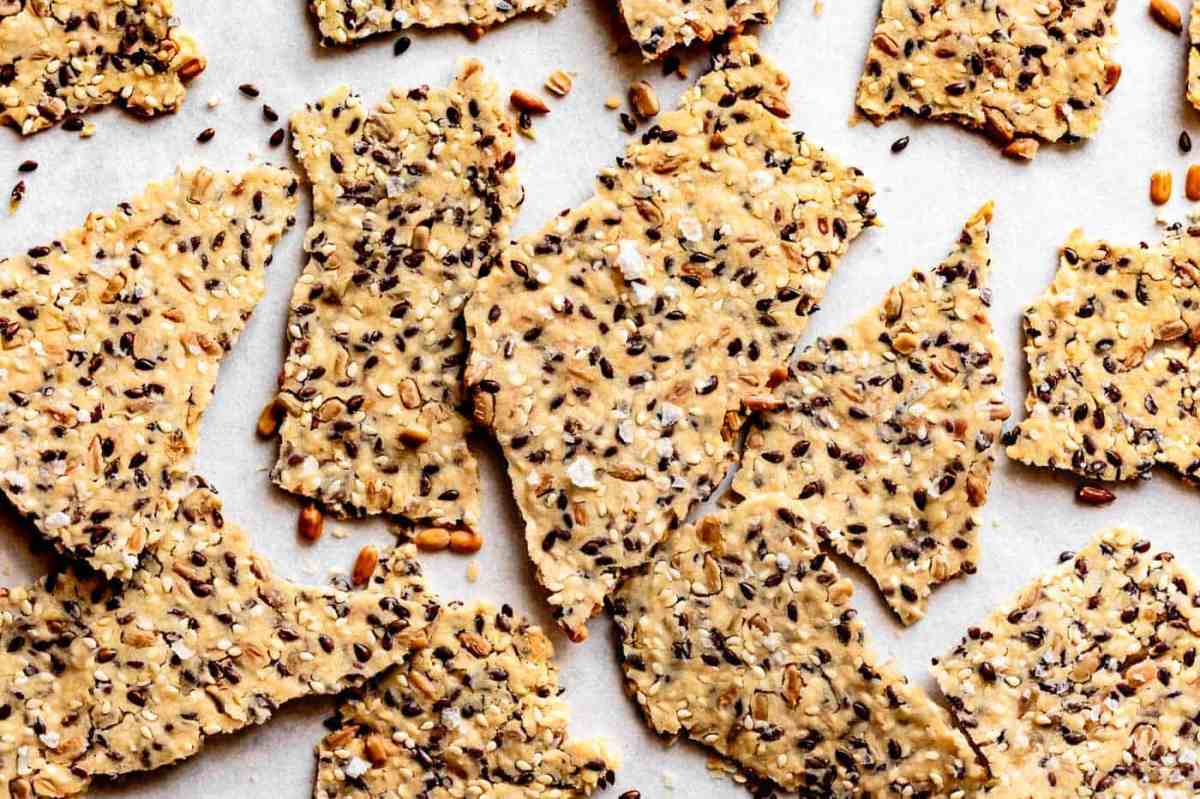Imagine the satisfying crunch of perfectly baked paleo crackers, crafted with simple, wholesome ingredients right in your own kitchen. Forget bland, store-bought options; this journey unveils the secrets to creating crispy, flavorful crackers that are as healthy as they are delicious. We’ll explore diverse recipes, from nutty almond flour versions to subtly sweet coconut flour delights, each offering a unique textural and flavor experience. Mastering the art of paleo cracker baking is easier than you think, and the results are undeniably rewarding.
This guide provides a comprehensive exploration of creating easy paleo crackers, covering everything from selecting the perfect flour blend to achieving that ideal crispiness. We’ll delve into step-by-step instructions, ingredient substitutions, storage tips, and creative serving suggestions, ensuring you become a confident paleo cracker artisan. Prepare to embark on a culinary adventure filled with satisfying textures and unforgettable flavors.
Step-by-Step Baking Process

Creating perfectly crisp and flavorful paleo crackers requires attention to detail at each stage. From achieving the right dough consistency to mastering the baking technique, the following steps will guide you towards cracker perfection. Remember, patience and precision are key ingredients in this recipe!
The process begins with combining your dry and wet ingredients to form a cohesive dough. Proper hydration is crucial for achieving the desired texture. Too much moisture will result in soggy crackers, while too little will yield crumbly ones. The ideal dough should be slightly sticky but manageable enough to roll out.
Dough Preparation and Rolling
The following steps Artikel the process of preparing and rolling the paleo cracker dough. Each step is vital for creating evenly baked, uniformly textured crackers.
- Mixing the Dough: Gently combine all dry ingredients in a large bowl. Slowly incorporate the wet ingredients, mixing until a slightly sticky dough forms. Avoid overmixing, which can lead to tough crackers.
- Resting the Dough: Cover the dough with plastic wrap and let it rest for at least 15 minutes. This allows the gluten-free flours to hydrate properly, resulting in a more manageable dough and improved cracker texture.
- Rolling the Dough: On a lightly floured surface, roll out the dough to your desired thickness (about 1/8 inch is ideal for crisp crackers). Use a rolling pin to achieve an even thickness, avoiding any thick or thin spots. Imagine rolling out a perfectly smooth, even sheet of dough, like a sheet of high-quality pastry.
- Cutting the Crackers: Use a sharp knife or pizza cutter to cut the dough into your desired shapes and sizes. A clean cut ensures even baking and prevents the crackers from sticking together during baking.
Baking for Crispness
Baking time and temperature are critical factors influencing the final crispness of your paleo crackers. The following information will guide you towards achieving perfectly crisp crackers while avoiding common baking pitfalls.
- Preheating the Oven: Preheat your oven to 350°F (175°C). Ensure the oven is thoroughly preheated before placing the crackers in to promote even baking.
- Baking Time and Temperature: Bake for 12-15 minutes, or until the edges are golden brown and the crackers feel crisp to the touch. Keep a close eye on them during the last few minutes, as they can quickly burn.
- Cooling Completely: Once baked, remove the crackers from the oven and let them cool completely on a wire rack. This allows them to fully crisp up and prevents them from becoming soggy.
Troubleshooting Common Baking Issues
Addressing common baking issues is key to consistently achieving perfect results. Understanding the causes and solutions for these problems can prevent wasted batches and ensure delicious crackers every time.
- Burnt Edges: Reduce the oven temperature by 25°F (15°C) and/or check the crackers more frequently during the last few minutes of baking. Consider placing a baking sheet on the rack below to reduce direct heat.
- Soft Center: Increase the baking time by 2-3 minutes or slightly increase the oven temperature. Ensure the dough is rolled thinly and evenly to promote uniform baking.
- Unevenly Baked Crackers: Rotate the baking sheet halfway through baking to ensure even heat distribution. Ensure your oven is preheated properly and that the oven rack is positioned correctly.
Visual Guide to Perfectly Baked Paleo Crackers
Visual cues are important indicators of properly baked crackers. The following descriptions illustrate the ideal appearance and texture at various stages.
Before Baking: The rolled-out dough should be evenly thick, with a smooth, slightly sticky surface. Imagine a perfectly uniform sheet of dough, ready to be transformed by the oven’s heat.
Mid-Baking: The edges will begin to turn golden brown, and the crackers will start to firm up. The color will be a light, even golden brown, similar to the color of lightly toasted bread.
After Baking: The crackers will be a deep golden brown, crisp to the touch, and easily breakable. They should have a slightly firm yet delicate texture, similar to a well-made crispbread. The color will be consistent throughout, with no dark brown or burnt spots.
Ingredient Substitutions and Alternatives
Adapting a paleo cracker recipe to suit individual dietary needs and preferences is straightforward. Many ingredients offer viable alternatives, each impacting the final product’s texture and flavor profile in unique ways. Understanding these substitutions allows for creative experimentation and personalized cracker creation.
Alternative Flours
The foundation of most paleo crackers is a blend of flours. Almond flour is a popular choice, providing a subtly sweet and slightly nutty flavor, and a relatively fine texture. However, other options exist. Coconut flour, for instance, offers a denser, more crumbly cracker with a distinct coconut taste. This requires careful attention to moisture levels as coconut flour is highly absorbent. Cassava flour produces a lighter, crispier cracker with a neutral flavor, making it a good option for those sensitive to nut allergies. Sunflower seed flour presents a slightly earthy flavor and a medium-textured cracker. The choice of flour significantly influences the cracker’s final texture and taste, impacting its overall mouthfeel and appeal. Experimenting with different flour combinations can yield interesting results. For example, a blend of almond and coconut flour might create a cracker that is both crisp and subtly sweet.
Sweetener Alternatives
Many paleo cracker recipes incorporate sweeteners like maple syrup or honey to add flavor and enhance browning. However, these can be replaced. For those seeking a less intense sweetness, a small amount of unsweetened applesauce can add moisture and a mild sweetness. Alternatively, dates, blended into a paste, offer a naturally sweet and sticky texture, similar to honey but with a deeper, fruitier note. The choice of sweetener, or its omission entirely, directly affects the sweetness level and the overall flavor profile of the finished crackers. A recipe without added sweeteners will be savory, while those with honey or maple syrup will have a distinct sweetness that complements the other ingredients.
Oil Substitutions
Olive oil is frequently used in paleo cracker recipes, imparting a fruity flavor and contributing to a desirable crispness. However, other healthy oils are suitable substitutes. Avocado oil offers a mild flavor and a high smoke point, making it suitable for achieving a crisp texture. Coconut oil, while adding a distinct coconut flavor, provides a unique richness and slight sweetness. The choice of oil impacts not only the flavor but also the cracker’s texture and its ability to crisp during baking. Avocado oil will yield a neutral-flavored cracker, while coconut oil will contribute a noticeably tropical flavor.
Allergen Considerations and Alternatives
Paleo crackers, while often naturally free of grains and common allergens like dairy, can still contain potential allergens. Nut flours, for example, are common ingredients. Individuals with nut allergies should substitute sunflower seed flour, pumpkin seed flour, or tapioca flour. Similarly, some recipes may include sesame seeds, another potential allergen. These should be omitted entirely or replaced with other seeds, such as flax or chia seeds, depending on the desired texture and nutritional profile. Careful ingredient selection is crucial for those with allergies or sensitivities. Always read labels thoroughly and ensure all ingredients are safe for consumption.
Nutritional Profile Comparisons
Different paleo cracker recipes vary significantly in their nutritional profiles. Crackers made primarily with almond flour will be higher in healthy fats and protein compared to those made with cassava flour, which is higher in carbohydrates. The addition of seeds, such as chia or flax, boosts the fiber content and provides additional omega-3 fatty acids. The inclusion of sweeteners will naturally increase the sugar content. By carefully selecting ingredients, one can tailor the nutritional composition of their paleo crackers to meet specific dietary goals, such as maximizing protein intake or increasing fiber consumption. For example, a cracker made with almond flour, sunflower seeds, and a touch of maple syrup would provide a good balance of healthy fats, protein, fiber, and a moderate amount of natural sweetness.
Creating homemade paleo crackers isn’t just about following a recipe; it’s about embracing a culinary journey of discovery. From the initial mixing of ingredients to the satisfying aroma filling your kitchen as they bake, the process is deeply rewarding. The end result? Crispy, flavorful crackers that are a testament to your culinary skills and a delicious addition to any meal. Whether enjoyed with dips, spreads, or simply on their own, these homemade treats offer a healthy and satisfying alternative to store-bought options. So, gather your ingredients, preheat your oven, and prepare for a delectable adventure in paleo baking.
Frequently Asked Questions
Can I use other types of nuts besides almonds in the almond flour recipe?
Yes, you can experiment with other nut flours like cashew flour or macadamia nut flour, but keep in mind that this will slightly alter the flavor and texture of the crackers.
How long do homemade paleo crackers stay fresh?
Stored properly in an airtight container at room temperature, your paleo crackers should remain crisp for about a week.
Can I make these crackers ahead of time?
Absolutely! Bake them ahead and store them in an airtight container for easy snacking throughout the week.
What if my crackers are too soft?
Try increasing the baking time slightly or reducing the amount of liquid in the dough. Ensure your oven is properly preheated.


